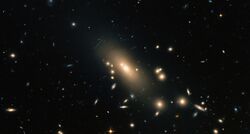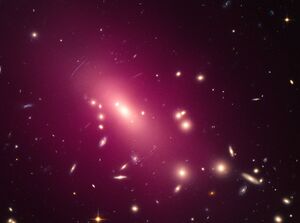Astronomy:Abell 1413
| Abell 1413 | |
|---|---|
 The cD elliptical galaxy Abell 1413 BCG dominates this image of Abell 1413. Note the arcs caused by gravitational lensing. Image by HST's WFC3/ACS.[1] | |
| Observation data (Epoch J2000) | |
| Constellation(s) | Between Leo and Coma Berenices |
| Right ascension | 11h 55m 18.9s[2] |
| Declination | +23° 24′ 31″[2] |
| Richness class | 3[3] |
| Bautz–Morgan classification | I[3] |
| Redshift | 0.1427[2] |
| Distance (co-moving) | 639.59 Mpc (2.1 billion ly) h−10.687[2] |
| ICM temperature | 7.38 keV[4] |
| Binding mass | 7.57×1014[4] M☉ |
Abell 1413 is a massive and rich type I galaxy cluster straddling the border between the constellations Leo and Coma Berenices, with the projected comoving distance of approximately 640 Mpc (2.1 billion ly). The cluster is especially notable due to the presence of its very large brightest cluster galaxy (BCG), one of the most extreme examples of its type, as well as one of the largest galaxies known. The cluster was first noted by George O. Abell in 1958.[5]
History
Abell 1413 is one of the original 2,712 galaxy clusters compiled in the Abell catalogue, compiled by the American astronomer George O. Abell in 1958, using data retrieved from the National Geographic Society – Palomar Observatory Sky Survey.[5]
Characteristics
Abell 1413 is classified as a type I galaxy cluster, characterized due to the presence of a single, massive galaxy in its center that dominates its smaller members. Thomas W. Noonan in 1971 characterized the cluster as having 60% the richness of the Coma Cluster, based on the assumption that the central cD elliptical is not a foreground object.[6]
Abell 1413 BCG
| Abell 1413 Brightest Cluster Galaxy | |
|---|---|
 Detail of the supergiant elliptical galaxy Abell 1413 BCG, taken by the Chandra X-ray Observatory overlaid with optical wavelength data | |
| Observation data (J2000 epoch) | |
| Constellation | Leo |
| Right ascension | 11h 55m 18.00s[7] |
| Declination | +23° 24′ 17.81″[7] |
| Redshift | 0.14291[7] |
| Helio radial velocity | 42,843.95±100.13 km/s[7] |
| Galactocentric velocity | 42,811±100 km/s[7] |
| Distance (comoving) | 0 ± 637.45 Mpc (0×109 ± 2×109 ly)h−10.678[7] |
| Group or cluster | Abell 1413 |
| Apparent magnitude (V) | 17.82[7] |
| Characteristics | |
| Type | E; BrClG[7] |
| Size | 245.71 kpc (801,000 ly) (diameter; 25.0 mag/arcsec2 r-band isophote (SDSS)[7] |
| Other designations | |
| MCG +04-28-097; WISEA J115518.00+232418.2; 2MASX J11551798+2324177; OGC 32; PGC 37447; Abell 1413 A | |
The brightest cluster galaxy of Abell 1413, or Abell 1413 BCG (MCG 04-28-097) is the supergiant elliptical galaxy that is the dominant member of the cluster. As early as 1965, astronomers William Wilson Morgan and Janet Rountree Lesh pointed out the galaxy's extreme nature, citing it as a "very large and luminous central galaxy" that could possibly be the largest of all cD ellipticals discovered, and hence must be checked for being a possible foreground object.[8] During the following decade, several other papers observed the cluster, particularly its cD galaxy, hence revealing its very extreme properties. It was stated to be among the most luminous galaxies known,[9] [10] and was found to have a titanic envelope.[11][12] Following studies would then publish extremely large effective radii for the central galaxy.[13][14]
Abell 1413 BCG is also notable due to its extreme ellipticity, making it the most elliptical brightest cluster galaxy known. It is rare for brightest cluster galaxies to have such an ellipticity; even then, Abell 1413 BCG is the most extreme known example of all of these.[15][16]
Further information
Abell 1413 is located 2 billion light years away from Earth between the constellations of Leo and Coma Berenices.[17] It is one of 4,073 clusters of galaxies at redshift (meaning they are moving away from earth,) that are somewhat close to the Earth.[citation needed] Abell 1413 holds about 300 galaxies together with its strong gravity. Due to the strong interactions in the cluster, the material is heated up to 100 million degrees. Because of this intense heat, strong X-ray radiation is emitted from the cluster.[17] Scientists using the Canada-France-Hawaii telescope observed Abell 1413 and built a sample of over 250 galaxies. These scientists consider Abell 1413 to be relaxed even though it has a highly elliptical shape.[15] The scientists also concluded that the cluster ellipticity at large radii is around .8 while the cluster ellipticity at the center is about .35, and that the cluster is aligned in the North-South direction, a few degrees westward.[15]
See also
References
- ↑ "Hubble reveals a super-rich galactic neighbourhood". ESA/Hubble. http://www.spacetelescope.org/images/potw1445a/.
- ↑ 2.0 2.1 2.2 2.3 "NED results for object ABELL 1413". NASA/IPAC Extragalactic Database (NED). http://ned.ipac.caltech.edu/cgi-bin/nph-objsearch?objname=Abell+1413&extend=no.
- ↑ 3.0 3.1 Abell, George O.; Corwin, Harold G. Jr.; Olowin, Ronald P. (May 1989). "A catalog of rich clusters of galaxies". Astrophysical Journal Supplement Series 70 (May 1989): 1–138. doi:10.1086/191333. ISSN 0067-0049. Bibcode: 1989ApJS...70....1A.
- ↑ 4.0 4.1 Table 4 from Vikhlinin, A.; Kravtsov, A.; Forman, W.; Jones, C.; Markevitch, M.; Murray, S. S.; Van Speybroeck, L. (April 2006). "Chandra Sample of Nearby Relaxed Galaxy Clusters: Mass, Gas Fraction, and Mass-Temperature Relation". The Astrophysical Journal (Chicago, Illinois, USA) 640 (2): 691–709. doi:10.1086/500288. Bibcode: 2006ApJ...640..691V.
- ↑ 5.0 5.1 Abell, George O. (May 1, 1958). "The Distribution of Rich Clusters of Galaxies.". The Astrophysical Journal Supplement Series 3: 211. doi:10.1086/190036. Bibcode: 1958ApJS....3..211A. https://ui.adsabs.harvard.edu/abs/1958ApJS....3..211A.
- ↑ Noonan, Thomas W. (February 1, 1972). "The Cluster of Galaxies Abell 1413". The Astronomical Journal 77: 9. doi:10.1086/111237. Bibcode: 1972AJ.....77....9N. https://ui.adsabs.harvard.edu/abs/1972AJ.....77....9N.
- ↑ 7.0 7.1 7.2 7.3 7.4 7.5 7.6 7.7 7.8 "By Name | NASA/IPAC Extragalactic Database". https://ned.ipac.caltech.edu/byname?objname=ACO+1413&hconst=67.8&omegam=0.308&omegav=0.692&wmap=4&corr_z=1.
- ↑ Morgan, W. W.; Rountree Lesh, Janet (1965). "The Supergiant Galaxies.". The Astrophysical Journal 142: 1364–1365. doi:10.1086/148422.
- ↑ Oemler Jr., A. (November 1974). "The Systematic Properties of Clusters of Galaxies. Photometry of 15 Clusters". Astrophysical Journal 194: 20. doi:10.1086/153216. Bibcode: 1974ApJ...194....1O. https://ui.adsabs.harvard.edu/abs/1974ApJ...194....1O/abstract. Retrieved 18 March 2023.
- ↑ Austin, T.B.; Peach, J.V. (September 1974). "Studies of rich clusters of galaxies - II. The structure and luminosity function of the cluster A 1413.". Monthly Notices of the Royal Astronomical Society 168 (3): 591–602. doi:10.1093/mnras/168.3.591. Bibcode: 1974MNRAS.168..591A. https://ui.adsabs.harvard.edu/abs/1974MNRAS.168..591A/abstract. Retrieved 18 March 2023.
- ↑ Oemler Jr., A. (November 1976). "The structure of elliptical and cD galaxies.". Astrophysical Journal 209: 17. doi:10.1086/154769. Bibcode: 1976ApJ...209..693O. https://ui.adsabs.harvard.edu/abs/1976ApJ...209..693O/abstract.
- ↑ Schombert, James M. (May 1988). "The Structure of Brightest Cluster Members. III. cD Envelopes". Astrophysical Journal 328: 14. doi:10.1086/166306. https://ui.adsabs.harvard.edu/abs/1988ApJ...328..475S/abstract. Retrieved 23 March 2023.
- ↑ Tonry, John L. (1987). "Properties of CD galaxies.". Proceedings of the 127th symposium of the IAU held in Princeton, U.S.A.: 10. doi:10.1007/978-94-009-3971-4_7. https://ui.adsabs.harvard.edu/abs/1987IAUS..127...89T/abstract. Retrieved 20 March 2023.
- ↑ Schombert, James M. (August 1987). "The Structure of Brightest Cluster Members. II. Mergers". Astrophysical Journal Supplement 64: 24. doi:10.1086/191212. https://ui.adsabs.harvard.edu/abs/1987ApJS...64..643S/abstract. Retrieved 20 March 2023.
- ↑ 15.0 15.1 15.2 Castagné, D.; Soucail, G.; Pointecouteau, E.; Cappi, A.; Maurogordato, S.; Benoist, C.; Ferrari, C. (2012). "Deep optical observations of the massive galaxy cluster Abell 1413" (in en). Astronomy & Astrophysics 548: A18. doi:10.1051/0004-6361/201116837. ISSN 0004-6361. Bibcode: 2012A&A...548A..18C. https://www.aanda.org/articles/aa/full_html/2012/12/aa16837-11/aa16837-11.html#T2.
- ↑ Porter, Alain C.; Schneider, Donald P.; Hoessel, John G. (May 1991). "CCD Observations of Abell Clusters. V. Isophotometry of 175 Brightest Elliptical Galaxies in Abell Clusters". Astrophysical Journal 101: 35. doi:10.1086/115788. https://ui.adsabs.harvard.edu/abs/1991AJ....101.1561P/abstract. Retrieved 22 March 2023.
- ↑ 17.0 17.1 "Hubble Views Galaxy Cluster Abell 1413" (in en-US). SciTech Daily. 2014-11-10. https://scitechdaily.com/hubble-views-galaxy-cluster-abell-1413/.
Coordinates: ![]() 11h 55m 18.9s, +23° 24′ 31″
11h 55m 18.9s, +23° 24′ 31″
 |

